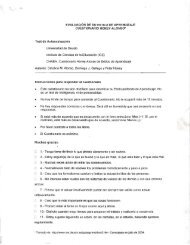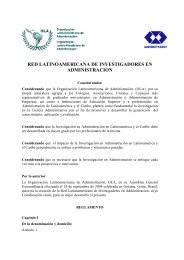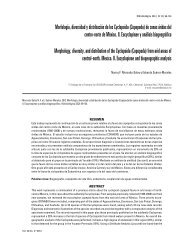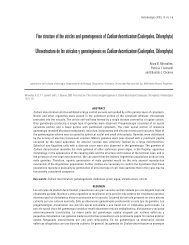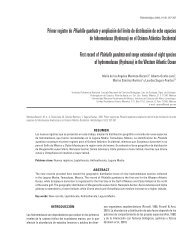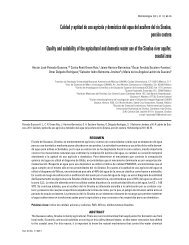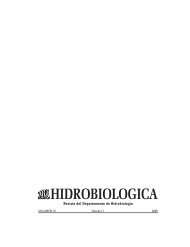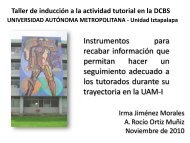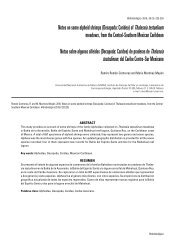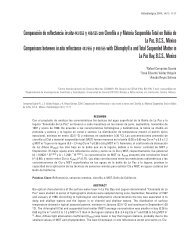21 (1): 26-33
21 (1): 26-33
21 (1): 26-33
You also want an ePaper? Increase the reach of your titles
YUMPU automatically turns print PDFs into web optimized ePapers that Google loves.
<strong>26</strong> Hendrickx, Hidrobiológica M. E. and2011,Wicksten,<strong>21</strong> (1): <strong>26</strong>-<strong>33</strong>M. K.New distribution ranges and records of caridean shrimps (Crustacea: Decapoda: Caridea) fromthe west coast of MexicoNuevos intervalos de distribución y registros de camarones carideos (Crustacea: Decapoda:Caridea) de la costa oeste de MéxicoMichel E. Hendrickx 1 and Mary K. Wicksten <strong>21</strong> Laboratorio de Invertebrados Bentónicos, Unidad Académica Mazatlán, Instituto de Ciencias del Mar yLimnología, Universidad Nacional Autónoma de México. P.O. Box 811 Mazatlán, Sinaloa, México.2Department of Biology, Texas A & M University, College Station, Texas 77843, USA.e-mail: michel@ola.icmyl.unam.mxHendrickx M. E. and M. K. Wicksten. 2011. New distribution ranges and records of caridean shrimps (Crustacea: Decapoda: Caridea) from the west coast ofMexico. Hidrobiológica <strong>21</strong>(1): <strong>26</strong>-<strong>33</strong>.AbstractGeographic records are presented for 24 species of Caridea (Crustacea: Decapoda) along Pacific coast of Mexico,in the East Pacific. New records are presented for Psathyrocaris fragilis Wood-Mason, 1893 (from Peru to Mexico),Periclimenes infraspinis (Rathbun, 1902), Pontonia margarita Smith, 1869, Alpheus cristulifrons Rathbun, 1900, Alpheusumbo Kim & Abele, 1988, Automate rugosa Coutière, 1900, and Lysmata californica (Stimpson, 1866) (within the Gulf ofCalifornia), and Typton hephaestus Holthuis, 1951 (from the Gulf of California to the Gulf of Tehuantepec, Mexico). Additionalrecords are given that establish the presence of species at intermediate localities within the Gulf of Californiaand along the southwestern coast of Mexico.Key words: Caridea, new records, Pacific MexicoResumenSe recolectaron especímenes de 24 especies de Caridea (Crustacea: Decapoda) en la costa del Pacífico de México,en el Pacífico Este. Nuevos registros geográficos son señalados para Psathyrocaris fragilis Wood-Mason, 1893 (desdePerú hasta México), Periclimenes infraspinis (Rathbun, 1902), Pontonia margarita Smith, 1869, Alpheus cristulifronsRathbun, 1900, Alpheus umbo Kim & Abele, 1988, Automate rugosa Coutière, 1900 y Lysmata californica (Stimpson,1866) (en el Golfo de California) y para Typton hephaestus Holthuis, 1951 (del Golfo de California hasta el Golfo de Tehuantepec,México). Se proporciona información adicional acerca de la presencia de algunas especies en localidadesintermedias en el Golfo de California y a lo largo de la costa suroeste de México.Palabras clave: Caridea, nuevos registros, Pacífico mexicanoIntroductionMarine biodiversity and biogeography studies are based on floristicand faunistic records available for distinct regions of theworld. National or regional collections of species are of paramountimportance in this respect. Any attempt to increase orcomplete their holdings indirectly favour a better understandingof species distribution and richness in natural environments. Thesafest and most adequate way are direct observations, whenHidrobiológica
Records caridean shrimps western Mexico 27possible (i.e., in the intertidal, in shallow water, or with roboticdevices in deep water), which contribute to our knowledge onabundance, behaviour and composition of the flora and fauna.However, collection of specimens in the field still representsthe safest and more adequate way to study the richness ofthe sea.The west coast of Mexico is particularly interesting due tothe confluence of several geographic provinces, including thewarm temperate California Province (under the influence of theCalifornia Current), the Cortés Province (covering the Gulf ofCalifornia and the SW tip of the Baja California Peninsula), witha high degree of endemism, and the tropical waters of the MexicanProvince (south of the Gulf of California to ca. 16°N). To thesouth it continues to the northern end of the Panamic Province(south of 16°N to the Guatemala border) (Brusca & Wallerstein,1979; Brusca, 1980; Hendrickx, 1992; Hendrickx et al., 2005; Espinosa-Pérez& Hendrickx, 2006). This mixture of fauna makes thewest coast of Mexico particularly attractive for distributionalstudies.Decapod crustaceans are undoubtedly one of the bestknown groups of marine invertebrates in the eastern tropicalPacific. Among these, the Caridea has received much attention.We have considerable knowledge of species compositionof this group in distinct habitats in the area and of their largescalegeographic distribution (see Wicksten & Hendrickx, 2003).In many cases, however, we still lack useful information on localgeographic or bathymetric distributions and on the relative importanceof species in their habitat in terms of abundance and trophicrelationships. Also, due to strong pressure on some marinecoastal habitats, it is important to gather records on the presenceof the species for long periods of time. This obviously includes theuse of field samples obtained in the past that have not yet beenstudied.Much information on ranges of decapod crustacean speciesin the eastern tropical region is based on the Allan Hancock PacificExpeditions (1936-1955). More recently, however, collectionsmade by Mexican institutions have considerably increased, allowingfor many new records and new species descriptions (seeBrusca, 1980; Wicksten, 1983; Hendrickx, 1993; Hendrickx et al.2005).This note reports on a series of 24 species of Caridea thatwere collected between 1979 and 2004 in natural ecosystemsalong the west coast of Mexico.Material and MethodsSamples were either collected by hand or with small devices (e.g.,shovel, hand nets) in coastal environments, or aboard the R/V “ElPuma” of the Universidad Nacional Autónoma de México (UNAM)during cruises organized by the Laboratorio de InvertebradosBentónicos, ICML, Mazatlán (SIPCO, CORTES, TALUD cruises) orby other laboratories or institutions (CEEMEX, BIOCAPESS andAA8110 cruises). Unless indicated, material was collected by staffof the Laboratorio de Invertebrados Bentónicos. All the specimensreported herein have been deposited in the Regional Collection ofMarine Invertebrates (EMU), ICML, UNAM, in Mazatlán, Mexico.Abbreviations are: St., sampling station; CL, carapace length (fromorbit to posterior margin of carapace); ovig., ovigerous; coll. collector.Unless it is indicated, specimens were not sexed and notmeasured. To avoid confusion in translating geographic localitieswhere material was collected or previously reported, all nameswere used in their Spanish spelling.Systematic sectionResultsSuperfamilia Pasiphaeoidea Dana 1852Familia Pasiphaeidae Dana 1852Leptochela serratorbita Bate, 1888Material examined.- Bahía de Mazatlán, C10 B/E FC1, St. 3(23°12’13”N, 106°27’<strong>21</strong>”W), 1 specimen, 11/Apr/1980, Van Veengrab, 13 m (EMU-8840-C). Bahía de Mazatlán, C11 B/E FC1, St. 4(23°13’23”N, 106°27’20”W), 1 specimen, 30/Abr/1980 (EMU-8840-A). South of Isla Carmen, CORTES 1, St. 10 (25°58’0”N, 111°7’0”W),4/May/1982, 2 specimens, 30 m (EMU-8844-A). Off Cabo SanMiguel, CORTES 2, St. <strong>21</strong> (28°8’18”N, 112°41’36”W), 1 specimen,13/Mar/1985, 108 m, otter trawl (EMU-8848). Off Banco Gorda, COR-TES 2, St. 57 (23°8’12”N, 109°<strong>26</strong>’42”W), 4 specimens, <strong>21</strong>/Mar/1985,56 m (EMU-8844-B). Bahía de Mazatlán (23°13’N, 106°27”W), dateunknown, 1 specimen, depth unknown (EMU-8840-B).Previous geographic records.- Eastern Pacific from Gulf ofCalifornia, Mexico, to Costa Rica; also in West Atlantic (Wicksten& Hendrickx, 2003).Remarks.-The present records confirm the presence of thisspecies throughout the Gulf of California.Psathyrocaris fragilis Wood-Mason, 1893Material examined.- TALUD XII cruise, St. 29 (19°19’37”N,105°<strong>26</strong>’20”W), 1 specimen, 2/Apr/2008, 1180-1299 m depth, benthicsledge (EMU-8864).Previous geographic records.- Off Peru, between ca. 8°43’Sand 6°13’S (Mendez, 1981). Also known from the Indo-Pacific andthe East Atlantic (Hendrickx & Estrada-Navarrete, 1989).Remarks.- The present record increases the known distributionrange to the north by 25 degrees of latitude.Vol. <strong>21</strong> No. 1 • 2011
28 Hendrickx, M. E. and Wicksten, M. K.Superfamilia Palemonoidea Rafinesque, 1815Familia Gnathophyllidae Dana, 1852Gnathophyllum panamense Faxon, 1893Material examined.- Guaymas (27°56’N, 111°5’W), 1 specimen,8/Feb/1986, rocky intertidal, open pool (EMU-8856-A).Previous geographic records.- Southern Baja California andSonora, Mexico, to Colombia; Islas Galápagos (Wicksten & Hendrickx,2003).Remarks.-The present record confirms the presence of thisspecies in the east-central Gulf of California.Familia PalaemonidaeMacrobrachium digueti (Bouvier, 1895)Material examined.- Río Baluarte, Rosario, Sinaloa (unknownlocality), 1 ovig. female and 4 specimens, 25/Oct/1980, shallowwater, hand net (coll. García Higuera) (EMU-8819).Previous geographic records.- Mulegé, Southern Baja Californiaand Sinaloa, Gulf of California, to Peru (Wicksten & Hendrickx,2003).Remarks.- Species of Macrobrachium, which inhabit riversand estuaries, are becoming endangered due to habitat destruction.The present record provides additional information on thedistribution of this species.Macrobrachium tenellum (Smith, 1871)Material examined.- Estero El Verde (23°25’30”N, 106°<strong>33</strong>’0”W),2 specimens, 11/Jul/1979, shallow water, hand net (EMU-8847).Previous geographic records.-Sonora, Río Mulegé, SouthernBaja California and Sinaloa, to Guerrero, Mexico; south to Peru(Wicksten & Hendrickx, 2003; Román, 2004).Remarks.-The present record confirms the unusual habitat(estuarine) for this threatened species. Most Macrobrachiumspecies are restricted to freshwater but M. tenellum has beenfound in water with salinity up to 22 o / oo . Of all species of Macrobrachiumoccurring in rivers drainage and coastal lagoons alongthe west coast of Mexico, M. tenellum is the most frequentlyreported (see Hendrickx, 1984; Román, 2004; Hernández et al.,2007).Palaemon ritteri Holmes, 1895Material examined.- Ensenada de Bacochibampo (27°54’42”N,110°56’58”W), 2 females, 6/Mar/1992, 1-2 m (EMU-8813).Previous geographic records.- Southern California, USA,and Gulf of California from San Felipe to La Paz, Baja California,and from Puerto Peñasco to Guaymas, Sonora (Wicksten 1983);southwards to Peru; Tres Marías, Cocos and Galapagos islands(Wicksten & Hendrickx, 2003).Remarks.-The present record confirms the presence of thisspecies in the southeastern Gulf of California.Palaemonella holmesi (Nobili, 1907)Material examined.- Bahía de Mazatlán (23°13’0”N,106°27’0”W), 1 specimen, 7/Jul/1979 (coll. Marco Leopoldo OrozcoRomo) (EMU-8820). Off Cabo San Miguel, CORTES 1 cruise, St. 19(28°8’42”N, 112°48’12”W), 1 ovig. female, 6/May/1982, 30 m (EMU-8837). Off Cabo San Miguel, CORTES 3 cruise, St. 19, (28°8’24”N,112°47’12”W), 1 specimen, 1/Aug/1985, 23 m (EMU-8811). Beachat Piedras Pintas, Guaymas (27°56’5”N, 111°5’5”W), 3 specimens,24/Mar/1997, 3 m, scuba diving, among algae and rocks (EMU-8816-A). Bahía Sendero Viejo, Guaymas (27°52’0”N, 110°52’<strong>26</strong>”W),one specimen, 27/Mar/1997, 2 m, scuba diving, among algae androcks (EMU-8816-B).Previous geographic records.- Southern California, USA,and Central Gulf of California, from Cabo San Miguel, Baja California,and El Desemboque, Sonora, to Ecuador; Tres Marías, Revillagigedoand Galapagos islands (Wicksten, 1983; Wicksten &Hendrickx, 2003).Remarks.-The present records confirm the presence of thisspecies in the southeastern Gulf of California and provide newrecords within the recorded range.Periclimenes infraspinis (Rathbun, 1902)Material examined.- Off Punta San Marcial, CORTES 2cruise, St. 8 (25°34’12”N, 110°59’12”W), 1 specimen, 11/Mar/1985,52 m (EMU-8822). Off Punta San Marcial, CORTES 3 cruise, St.8 (25°<strong>33</strong>’24”N, 110°59’48”W), 3 ovig. females, 30/Jul/1985, 52m (EMU-8854). Off Punta San Marcial, CORTES 3 cruise, St. 10(25°58’18”N, 111°7’12”W), 1 ovig. female and 1 specimen, 30/jul/1985, 30 m (EMU-8827). Off Punta Tepoca, CORTES 3 cruise,St. 42 (30°12’30”N, 112°50’0”W), 5 specimens, 5/Aug/1985, 23 m(EMU-8838).Previous geographic records.- Southern California, USA, andScammon’s Lagoon, Baja California; from “Marcial Rock” (PuntaMarcial), and Estero El Soldado, Sonora, in the northern Gulf ofCalifornia, Mexico, to Costa Rica; Islas Galápagos (Wicksten &Hendrickx, 2003).Remarks.- The Tepoca material is about 4°40’ degrees oflatitude north of the previous northernmost record (i.e., Punta SanHidrobiológica
Records caridean shrimps western Mexico 29Marcial). The additional records confirm the continued presenceof this species within its recorded range.Pontonia margarita Smith, 1869Material examined.- Guaymas (ca. 27°56’N, 111°5’W), 4specimens, date unknown, intertidal (coll. L.T. Findley) (EMU-8830). Mazatlan harbour (23°10’41”N, 106°25’29”W), 2 specimens,23/Mar/1983, 7 m (coll. Gustavo Klein Barreda) (EMU-8855). IslaChivos, Mazatlán (23°10’42”N, 106°24’43”W), 3 males and 3 females,3/Dec/1987, scuba diving, “madre perla” (EMU-8865).Previous geographic records.- Southern Gulf of California toColombia; Tres Marías and Galapagos islands (Wicksten & Hendrickx,2003).Remarks.- The Guaymas material represents a northernrange extension of this species (by ca. two degrees of latitude),previously know up to Bahía Agua Verde (25°31”N, 111°0”W),east coast of Southern Baja California. There are three previousrecords of this species in the Southern Gulf of California: two inBahía Mazatlán (EMU-876; EMU-1097) and one in La Paz (EMU-875) (Hendrickx, 1994).Pontonia simplex Holthuis, 1951Material examined.- Isla Puercos, Barra de Navidad(19°11’20”N, 104°40’34”W), 1 specimen, 8/Sep/1983, intertidal(coll. Carlos Escobar Nataren) (EMU-88<strong>21</strong>).Previous geographic records.- Only known from Puerto Escondido,Baja California, in the Southern Gulf of California, andBahía Tenacatita, Colima, Mexico; also recorded in Panama(Wicksten & Hendrickx, 2003).Remarks.- The specimen from Barra de Navidad is the thirdrecord for Mexico.Typton hephaestus Holthuis, 1951Material examined.- Off Río Suchiate, Gulf of Tehuantepec,CEEMEX P7 cruise, St. 39 (14°<strong>21</strong>’48”N, 92°34’24”W), 2 specimens,13/May/1992, 64 m (EMU-8842). Barra de Navidad (19°11’24”N,104°41’38”W), 1 specimen of probably that species, 11/Sep/1982,intertidal (EMU-8828).Previous geographic records.- “Scammon’s Lagoon” (LagunaOjo de Liebre) and La Paz, Baja California; Islas Tres Marías(Wicksten & Hendrickx, 2003).Remarks.- The material examined herein represents twosouthern extensions of the distribution range of this species, fromTres Marías (ca <strong>21</strong>°36’N, 106°24’W) all the way to the Gulf of Tehuantepec(ca. 7°15’ degrees of latitude to the south).Superfamilia Alpheoidea Rafinesque, 1815Familia Alpheidae Rafinesque, 1815Alpheus bellimanus Lockington, 1877Material examined.- Off Cabo San Miguel, CORTES 3, St. 19(28°8’24”N, 112°47’12”W), 5 specimens, 1/Aug/1985, 23 m (EMU-8812). Off Río Copalita, CEEMEX P7, St. 3 (15°46’6”N, 96°1’30”W), 1specimen, 14/May/1992, 48 m (EMU-8841).Previous geographic records.- California, USA, and throughoutthe Gulf of California, Mexico (Hendrickx & Hermoso-Salazar,2005), to Chile; Revillagigedo and Galapagos islands (Wicksten &Hendrickx, 2003).Remarks.- The only previous record of this species in the Gulfof Tehuantepec is east of Salina Cruz and off Tonala (Hendrickx& Vazquez-Cureño, 1998; Hendrickx & Hermoso-Salazar, 2005).There are few records of this species in the central Gulf of California,where the specimen from off Cabo San Miguel was taken.Alpheus utriensis Ramos & Von Prahl, 1989Material examined.- Off Cabo San Miguel, CORTES 3, St. 19(28°08’24”N, 112°47’12”W), 2 specimens, 1/Aug/1985, 27 m (EMU-8810).Previous geographic records.- Puerto Escondido, SouthernGulf of California, Mexico, to Colombia (also in the Atlantic) (Wicksten& Hendrickx, 2003; Anker et al., 2008).Remarks.- The present record represents a northern rangeextension of this species in the Gulf of California. The materialfrom Cabo San Miguel was collected simultaneously with thespecimens reported by Hendrickx & Hermoso-Salazar (2005). Inwestern Mexico, A. utriensis also is known only from Isla Isabel(Kim & Abele, 1988), Puerto Escondido (Wicksten, 1983), and theIslas Tres Marías (Hendrickx & Hermoso-Salazar, 2005, previousrecords in Mexico as A. cristulipes).Alpheus umbo Kim & Abele, 1988Material examined.- Guaymas (27°56’N, 111°5’W), 1 specimen,3/Feb/1986, intertidal (EMU-8858). Punta Mita, near village(20°47’20”N, 105°31’5”W), 2 specimens of probably that species,12/Nov/2004, intertidal (EMU-88<strong>33</strong>).Previous geographic records.- Angel de la Guarda, SanFrancisco, Espíritu Santo, Tres Marías islands, and La Paz, eastcoast of Baja California; south to Colombia (Kim & Abele, 1988;Wicksten & Hendrickx, 2003).Remarks.- The Guaymas material represents the first recordalong the east coast of the Gulf of California. The specimens fromVol. <strong>21</strong> No. 1 • 2011
30 Hendrickx, M. E. and Wicksten, M. K.Punta Mita constitute the first record of this species from thesouthwestern coast of Mexico.Automate cf. dolichognatha de Man, 1888Material examined.- Off Río Fuerte, CORTES 1, St. 51,(25°39’36”N, 109°30’36”W), 1 specimen, 12/May/1982, 56 m (EMU-8849).Previous geographic records.- Automate dolichognatha isknown from Southern California, USA, to Peru, including two records(Laguna Percebu and Isla Espíritu Santo) along the westcoast of the Gulf of California; Tres Marías, Revillagigedo, Cocosand Galapagos islands (Wicksten & Hendrickx, 2003).Remarks.- The Río Fuerte material represents the first strictlycontinental record of this species along the east coast of the Gulfof California. Because the specimen was not in a very good stateof conservation and due to unresolved taxonomic difficulties, theidentification of this material is tentative.Automate rugosa Coutière, 1900Material examined.- Off Teacapan, SIPCO III, St. A1(22°24’12”N, 105°54’24”W), 2 specimens, 15/Jan/1982, 40 m (EMU-8845). Off Punta Tepoca, CORTES 2, St. 42 (30°12’6”N, 112°47’0”W),1 specimen, 17/Mar/1985, 30 m (EMU-8843). Off Punta Arboleda,CORTES 3, St. 15 (<strong>26</strong>°52’48”N, 110°5’54”W), 2 specimens, 31/Jul/1985, 46 m (EMU-8835).Previous geographic records.- Isla Cedros, Baja California,and Gulf of California northwards to Estero Tastiota, Sonora, Mexico;south to Panama (Wicksten & Hendrickx, 2003).Remarks.- The Punta Tepoca record is slightly north (aboutone degree of latitude) than previous northernmost record at EsteroTastiota.Hippolytidae Bate, 1888Hippolyte williamsi Schmitt, 1924Material examined.- Punta Mita, near village (20°47’20”N,105°31’5”W), 10 specimens, 12/Nov/2004, intertidal, rocky shore(EMU-8832).Previous geographic records.- Sonora, Mexico, to Chile, includingZihuatanejo, Guerrero (Wicksten, 1983); Islas Galápagos(Wicksten & Hendrickx, 2003).Remarks.- The material from Punta Mita confirms the occurrenceof this species between the Gulf of California and Zihuatanejo.Lysmata californica (Stimpson, 1866)Material examined.- Off Río Baluarte, BIOCAPESS III, St.13, (22°47’48”N, 106°54’42”W), 1 ovig. female, 19/Oct/1990, 25 m(EMU-8825).Previous geographic records.- Tomales Bay, California, toBahía Magdalena, northern Gulf of California, and to Guaymas(Wicksten, 2000; Wicksten & Hendrickx, 2003).Remarks.- The Río Baluarte material is a southern extensionof the species distribution range by about 5 degrees of latitudealong the east coast of the Gulf of California. An intertidal speciesin southern California, L. californica appears as a strictly subtidalspecies in the more southern part of its range.Lysmata galapagensis Schmitt, 1924Material examined.- Barra de Navidad (19°11’24”N,104°41’38”W), 2 specimens, <strong>21</strong>/Sep/1983, intertidal (coll. CarlosEscobar Nataren) (EMU-8836).Previous geographic records.- Bahía Magdalena, SouthernBaja California, and east coast of the Gulf of California to CostaRica and Panama; Tres Marías, Malpelo and Galapagos islands(Wicksten, 2000; Wicksten & Hendrickx, 2003).Remarks.-The present material confirms the presence of thisspecies on the southwestern coast of Mexico.Thor algicola Wicksten, 1987Material examined.- Guaymas (ca. 27°56’N, 111°5’W), 9specimens, 3/Feb/1986, intertidal (EMU-8857). Ensenada of Bacochibampo(27°54’42”N, 110°56’58”W), 2 specimens, <strong>26</strong>/Mar/1992,depth unknown (EMU-8814). Beach at Piedras Pintas, Guaymas(27°56’5”N, 111°5’5”W), 7 specimens, 24/Mar/1997, 3 m,scuba diving, among algae and rocks (EMU-8809). Bahía SenderoViejo, Guaymas (27°52’0”N, 110°52’<strong>26</strong>”W), 5 specimens, 27/Mar/1997, 2 m, scuba diving (EMU-8815). Punta Mita, near village(20°47’20”N, 105°31’5”W), 2 specimens, 12/Nov/2004, intertidal(EMU-8831).Previous geographic records.- Throughout the Gulf of California,except in Sinaloa-Nayarit; in Zihuatanejo and Acapulco,Mexico, to Panama; Islas Tres Marías (Wicksten, 1987; Wicksten& Hendrickx, 2003)Remarks.-The present records from Punta Mita confirm thepresence of this species in the state of Nayarit and provide newrecords from areas within its recorded range.Hidrobiológica
Records caridean shrimps western Mexico 31Superfamilia Processoidea Ortmann, 1896Familia Processidae Ortmann, 1896Processa cf. aequimana (Paulsson, 1875)Material examined.- Bahía Algodones, San Carlos (27°57’0”N,111°5’42”W), 1 specimen, 25/Mar/1997, 3 m, scuba diving (EMU-8818). Beach at Punta Mita, near village (20°47’20”N, 105°31’5”W),3 specimens, 12/Nov/2004, rocky intertidal (EMU-8834).Previous geographic records.- Upper Gulf of California,Mexico, to Mazatlán. Also in the Indo-West Pacific (Wicksten &Hendrickx, 2003).Remarks.-The record from Punta Mita extends the range ofthis species in the eastern Pacific south by about three degrees oflatitude. The record from Bahía Algodones confirms the continuedpresence of the species within its known range. Identification ofthis material is tentative due to unresolved taxonomic difficulties.Processa peruviana Wicksten, 1983Material examined.- Off Punta Piaxtla, SIPCO III, St. C1(23°37’12”N, 106°55’54”W), 1 specimen, 16/Jan/1982, 45 m (EMU-8846). Off Banco Gordo, CORTES 1 cruise, St. 56 (23°7’0”N,109°25’0”W), 1 specimen, 13/May/1982, 82 m (EMU-8808-B). OffPunta San Marcial, CORTES 2, St. 9 (25°47’48”N, 111°4’24”W),1 specimen, 11/Mar/1985, 78 m (EMU-88<strong>26</strong>-A). Off Punta Willard,CORTES 2, St. 34 (30°11’24”N, 114°3’540”W), 1 specimen,15/Mar/1985, <strong>26</strong> m (EMU-8808-A). Off Estero Tastiota CORTES 2,St. 48 (28°16’12”N, 111°36’48”W), 1 specimen, 18/Mar/1985, 62 m(EMU-88<strong>26</strong>-B). Off Punta San Marcial, CORTES 3, St. 8 (25°<strong>33</strong>’24”N,110°59’48”W), 2 ovig. females, 30/Jul/1985, 52 m (EMU-8839). OffBahía Tepoca, CORTES 3, St. 42 (30°12’30”N, 112°50’0”W), 4 juvenilesof probably that species, 5/Aug/1985, 23 m (EMU-8823).Previous geographic records.- Southern California, USA, tosouthern Baja California, throughout the Gulf of California, Mexico,and to Peru; Islas Galápagos (Wicksten & Hendrickx, 2003).Remarks.- The frequent apparition of this species in samplestaken on the inner and mid sections of the continental platformindicates that it is a major component of the benthos communityin this habitat within the Gulf of California.Superfamilia Pandaloidea Haworth, 1825Familia Pandalidae Haworth, 1825Plesionika beebei Chace, 1937Material examined.- South of Isla San Pedro Nolasco,AA8110, St. 59-45 (27°51’0”N, 111°18’0”W), 34 specimens, 20/Oct/1981, between 0-300 m, plankton haul (EMU-8807). Off RíoFuerte, CORTES 3, St. 50 (25°49’54”N, 109°36’12”W), 1 specimen,8/Aug/1985, 93 m (EMU-8824).Previous geographic records.- Southern California, USA, toSouthern Baja California; central and southern Gulf of Californiato Peru (Wicksten & Hendrickx, 2003).Remarks.- There are only six records for this species in theGulf of California (Hendrickx & Wicksten, 1989; Hendrickx & Estrada-Navarrete,1996), some from plankton nets, others from bottomtrawls, but P. beebei certainly is a pelagic species incidentallycollected in bottom trawls rising to the surface (Hendrickx & Estrada-Navarrete,1996).Plesionika trispinus Squires & Barragán, 1976Material examined.- Off Isla Altamura, TALUD II, St. 41,(24°53’30”N, 108°40’12”W), 1 specimen, 29/Mar/1990, <strong>21</strong>1 m (EMU-8850).Previous geographic records.- Southern California, USA; SEGulf of California, Mexico, to Peru (Wicksten & Hendrickx, 2003).Remarks.- The record from Altamura slightly extends thenorthern range limit of this species by about half a degree oflatitude. There are only three previous records for this specieswithin the Gulf of California and one off the west coast of the BajaCalifornia Peninsula. There is, however, not a single record of itbetween the SE Gulf of California and the area corresponding toColombia-northern Peru (Hendrickx & Estrada-Navarrete, 1996).DiscusionConsidering the fact that the Pacific coast of Mexico extendsfrom the USA border to the border of Guatemala and covers partof the Californian zoogeographic province, the Cortés province,the Mexican province, and the northern end of the Panamic province(Espinosa-Pérez & Hendrickx, 2006), any new data related tospecies distribution is of interest as it can bring new light on thegeneral zoogeographic patterns in the eastern Pacific. The firstrecord for Pacific Mexico of Psathyrocaris fragilis is particularlyinteresting as pelagic decapods have been poorly studied in thearea, mostly due to the cost of sampling in open sea and the factthat large, pelagic gears (e.g., Isaac-Kidds midwater trawl) haveseldom been used (Hendrickx & Estrada-Navarrete, 1996). Whenrecords of caridean shrimp are reviewed, it becomes clear thatthere is a strong bias in favour of the most common, accessible,large or colourful species (e.g., genera Alpheus, Macrobrachium).On the other hand, there is a significant lack of data on the distributionof small species of Hippolytidae and Palaemonidae, althoughthese might represent an important trophic link in shallow,coastal ecosystems. Species associated with other invertebrateslike sponges, corals or other coral-associated species, are alsopoorly known and these peculiar habitats need to be investigat-Vol. <strong>21</strong> No. 1 • 2011
32 Hendrickx, M. E. and Wicksten, M. K.ed properly. In the last decade, two new species of Synalpheuswere found associated with sponges along the coast of Mexico(Hermoso-Salazar & Hendrickx, 2006) and four species of the raregenus Sandyella (including three new species) were collected inreefs around Clipperton Island (Li & Poupin, 2009; Marin, 2010).Only through the thorough revision of unidentified material thathas been held for many years in collections and museum withinMexico and in other countries (mostly in the USA), and by organizingmore intensive, modern exploratory expeditions aimed atcollecting rare or cryptic species, will we be able to understandhow species communities have reacted to the ongoing climaticchanges and the destruction of vital ecosystems.AcknowledgmentsWe thank all colleagues, students and crew members of R/V “ElPuma” for their support during the sampling activities. Financialsupport from CONACyT was made available for sampling operationsin Bahía de Mazatlán (project PCMANAL 79001), during theCORTES 2 and 3 cruises (project PCCBNA-0<strong>21</strong>996) and the TALUDIV-VII cruises (CONACyT contract 31805-N). CEEMEX materialwas collected during the TS2.0312 and Cl1.0431E projects. Wethank Mercedes Cordero for editing the final version of this manuscript.ReferencesAnker, A., C. Hurt, N. Knowlton. 2008. Revision of the Alpheus critulifronsspecies complex (Crustacea: Decapoda: Alpheidae) with descriptionof a new species from the tropical eastern Atlantic. Journal of theMarine Biologial Association of the United Kingdom 88 (3): 543-562.Brusca, R. C. 1980. Common intertidal invertebrates of the Gulf of California.The University of Arizona Press. U.S.A. 513 pp.Brusca, R. C. & B. R. Wallerstein. 1979. Zoogeographic patterns of idoteidisopods in the Northeast Pacific, with a review of shallow water zoogeographyof the area. Bulletin of the Biological Society of Washington3: 67-105Espinosa-Pérez, M. C. & M. E. Hendrickx. 2006. A comparative analysis ofbiodiversity and distribution of shallow water marine isopods (Crustacea:Isopoda) from polar and temperate waters in the East Pacific.Belgian Journal of Zoology 136 (2): <strong>21</strong>9-247.Hendrickx, M. E. 1984. Studies of the coastal marine fauna of southernSinaloa, México. II. The decapod crustaceans of Estero El Verde.Anales del Instituto de Ciencias del Mar y Limnología, UniversidadNacional Autónoma de México 11 (1): 23-48.Hendrickx, M. E. 1992. Distribution and zoogeographic affinities of decapodcrustaceans of the Gulf of California, Mexico. Proceedings ofthe San Diego Society of Natural History 20: 1-11.Hendrickx, M. E. 1993. Crustáceos decápodos del Pacífico Mexicano. In:Salazar-Vallejo, S.I. y N.E. González (Eds.). Biodiversidad Marina yCostera de México. Comisión Nacional de la Biodiversidad y CIQRO,México, pp. 271-318.Hendrickx, M. E. 1994. Catálogo de crustáceos decápodos y estomatópodos.Colección de Referencia, Estación Mazatlán, ICML, UNAM.Comisión Nacional para el Conocimiento y Uso de la Biodiversidad eInstituto de Ciencias del Mar y Limnología, UNAM, México. 134 p.Hendrickx, M. E. & F. D. Estrada Navarrete. 1989. A checklist of the speciesof pelagic shrimps (Penaeoidea and Caridea) from the easternPacific with notes on their geographic and depth distribution. Cal-Cofi Reports 30: 104-1<strong>21</strong>.Hendrickx, M. E. & F. D. Estrada Navarrete. 1996. Los camarones pelágicos(Crustacea: Dendrobranchiata y Caridea) del Pacífico mexicano.Comisión Nacional para el Conocimiento y Uso de la Biodiversidad eInstituto de Ciencias del Mar y Limnología, UNAM, México. 157 p.Hendrickx, M. E. & M. Hermoso Salazar. 2005. Distribution and habitat offour species of Alpheus Fabricius, 1798 (Alpheus bellimanus Lockington,1877; A. cristulifrons Rathbun, 1900; A. panamensis Kingsley,1878; and A. malleator Dana, 1852) (Caridea: Alpheidae) along thePacific coast of Mexico. Crustaceana 78 (4): 429-435.Hendrickx, M. E. & L. A. Vázquez Cureño. 1998. Composition and zoogeographicalaffinities of the stomatopod and decapod crustaceanscollected during the CEEMEX P4 cruise in the Gulf of Tehuantepec,Mexico. Bulletin de l’Institut Royal des Sciences Naturelles de Belgique68: 135-144.Hendrickx, M. E. & M. K. Wicksten. 1989. Los Pandalidae (Crustacea: Caridea)del Pacífico mexicano, con una clave para su identificación.Caldasia (Colombia) 16 (76): 71-86.Hendrickx, M. E., R. C. Brusca & L. T. Findley (eds.). 2005. A DistributionalChecklist of the Macrofauna of the Gulf of California, Mexico. Part I.Invertebrates. [Listado y Distribución de la Macrofauna del Golfo deCalifornia, México, Parte I. Invertebrados]. Arizona-Sonora DesertMuseum. Tucson, Az. USA. 429 p.Hermoso-Salazar, M. & M.E. Hendrickx, 2006. Two new species of SynalpheusBate, 1888 (Decapoda, Caridea, Alpheidae) from the SE Gulf ofCalifornia, Mexico. Crustaceana 78 (9) 1099-1116.Hernández, L., G. Murugan, G. Ruiz-Campos & A. Maeda-Martínez. 2007.Freshwater shrimp of the genus Macrobrachium (Decapoda: Palaemonidae)from the Baja California Peninsula, Mexico. Journal ofCrustacean Biology 27: 351-369.Kim, W., & L. G. Abele. 1988. The snapping shrimp genus Alpheus from theEastern Pacific (Decapoda: Caridea: Alpheidae). Smithsonian Contributionsto Zoology 454: 1-119.Li X. & J. Poupin, 2009. Report on some species of Palaemonidae (Decapoda:Caridea) from Clipperton Island. Journal of Crustacean Biology,29 (4) : 579-594.Marin I., 2010. A revision of the generic status of three species of theHidrobiológica
Records caridean shrimps western Mexico <strong>33</strong>genus Chacella Bruce, 1986 described by Li & Poupin (2009) (Crustacea:Decapoda: Palaemonidae). Zootaxa 2452: 67-68.2006.Méndez, M. 1981. Claves de identificación y distribución de los langostinosy camarones (Crustacea: Decapoda) del mar y ríos de la costadel Perú. Boletín del Instituto del Mar de Perú 5: 1-170.Román, R. 2004. The genus Probopyrus Giard & Bonnier, 1888 (Crustacea:Isopoda: Bopyridae) in the eastern Pacific with seven new recordsfor Mexico. In: M.E. Hendrickx (Ed.). Contributions to the Study ofEast Pacific Crustaceans 3. [Contribuciones al Estudio de los Crustáceosdel Pacífico Este 3] Instituto de Ciencias del Mar y Limnología,UNAM. México. pp. 153-168.Wicksten, M. K. 1983. A monograph on the shallow water caridean shrimpsof the Gulf of California, Mexico. Allan Hancock Monographs in MarineBiology 13: 1-59.Wicksten, M. K. 1987. Range extensions of offshore decapod crustaceansfrom California and western Mexico. California Fish and Game 73 (1):54-56.Wicksten M. K. 2000. The species of Lysmata (Caridea: Hippolytidae) fromthe eastern Pacific Ocean. Amphipacifica 2: 3-22.Wicksten, M. K. & M. E. Hendrickx. 2003. An updated checklist of benthicmarine and brackish water shrimps (Decapoda: Penaoidea, Stenopodidea,Caridea) from the Eastern Tropical Pacific. In: M.E. Hendrickx(Ed.). Contributions to the Study of East Pacific Crustaceans 2.[Contribuciones al Estudio de los Crustáceos del Pacífico Este 2]. Institutode Ciencias del Mar y Limnología, UNAM. México. pp. 49-76.Recibido: 10 de diciembre de 2010.Aceptado: 1 de abril de 2011.Vol. <strong>21</strong> No. 1 • 2011



